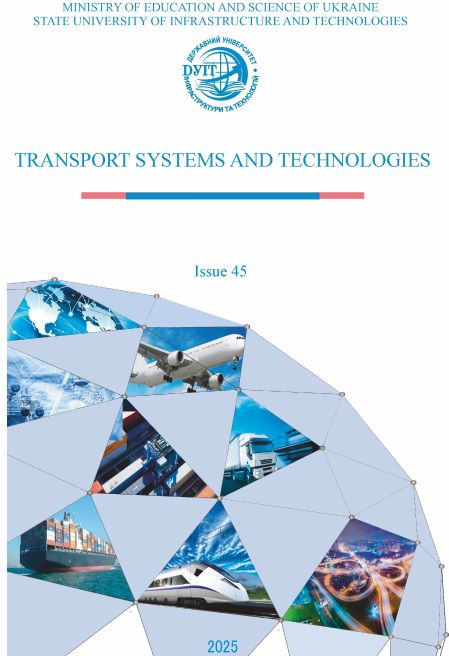Analysis of minimum safe approach distances based on vessels navigation safety domain
Keywords:
safety domain, vessel collision avoidance, approach distance, elliptical domain, collision evasion, vessel traffic managementAbstract
This article presents an analytical study of changes in the critical allowable approach distance between converging vessels, taking into account the shape of the vessel's safety zone. The research aims to address the important issue of ensuring maritime navigation safety by developing a mathematical approach for precise modeling of vessel domains under various approach scenarios. Analytical expressions are proposed and derived for calculating minimum safe distances for both elliptical zones and zones of complex configuration, allowing flexible assessment of approach situations depending on the relative motion of vessels. The analysis shows that although elliptical and complex-shaped domains differ geometrically, the nature of changes in critical approach distance in both cases remains similar, indicating the possibility of effective application of either model in practical conditions depending on the required level of detail and available computational resources. Graphical representation of the results clearly illustrates the dynamics of distance changes as a function of the angle between the courses of approaching vessels, which can be used in the development of software for navigation systems. The obtained dependencies allow not only quantitative assessment of allowable approach distances but also account for the influence of the approach aspect, which significantly affects the decision-making process by both navigators and automated collision avoidance systems. The results create a foundation for further improvement of collision avoidance algorithms and contribute to increasing the level of automation in navigation processes and overall maritime safety, especially in conditions of heavy traffic or restricted waterways.
References
Y., Wu, D., Wang, H., & Lou, J. (2025). Dynamic collision avoidance for maritime autonomous surface ships based on deep Q-network with velocity obstacle method. Ocean Engineering, 320, 120335. https://doi.org/10.1016/j.oceaneng.2025.120335.
Burmaka, I., Vorokhobin, I., Melnyk, O., Burmaka, O., & Sagin, S. (2022). Method of Prompt Evasive Manuever Selection to Alter Ship’s Course or Speed. Transactions on Maritime Science, 11(1), 7-15. https://doi.org/10.7225/toms.v11.n01.w01.
Chen, Y., Du, W., Hu, X., Bai, G., & Zhang, J. (2022). USV collision hazard assessment and track planning algorithm. Ocean Engineering, 261, 112149. https://doi.org/10.1016/j.oceaneng.2022.112149.
Bolbot, V., Gkerekos, C., Theotokatos, G., & Boulougouris, E. (2022). Automatic traffic scenarios generation for autonomous ships collision avoidance system testing. Ocean Engineering, 254, 111309. https://doi.org/10.1016/j.oceaneng.2022.111309.
Sahin, S. S., & Sahin, S. V. (2024). Use of a hybrid system for coordinating marine vessel movement during maneuvering in confined waters. Water Transport, 3(41), 208-215. [in Ukraine]. https://doi.org/10.33298/2226-8553.2024.3.41.24
Petrychenko, O. A. (2018). Method for choosing divergence maneuver using electronic chart. In Proceedings of the 10th International Scientific and Practical Conference "Modern Information and Innovative Technologies in Transport (MINTT-2018)" (pp. 128–130). Kherson: KhDMA.
Burmaka, I., Borodulin, A., Fedorov, D., & Petrychenko, O. (2021). External control of the divergence process taking into account the form of the safety domain. Transport Means - Proceedings of the International Conference, 2021-October, 579-583.
Sahin, S. V., & Sahin, S. S. (2023). Determining the method of marine transport vessel movement management during ensuring their safe divergence. Water Transport, 2(38), 187-195. [in Ukraine]. https://doi.org/10.33298/2226-8553.2023.2.38.20.
Vorokhobin, I., Burmaka, I., Fusar, I., & Burmaka, O. (2022). Simulation modeling for evaluation of efficiency of observed ship coordinates. TransNav: International Journal on Marine Navigation and Safety of Sea Transportation, 16(1), 137-141.
Zhou, J., Ding, F., Yang, J., Pei, Z., Wang, C., & Zhang, A. (2021). Navigation safety domain and collision risk index for decision support of collision avoidance of USVs. International Journal of Naval Architecture and Ocean Engineering, 13, 340–350. https://doi.org/10.1016/j.ijnaoe.2021.03.001.
Xu, X., Lu, Y., Liu, G., Cai, P., & Zhang, W. (2022). COLREGs-abiding hybrid collision avoidance algorithm based on deep reinforcement learning for USVs. Ocean Engineering, 247, 110749. https://doi.org/10.1016/j.oceaneng.2022.110749.
Zhou, X., Qu, M., Zhou, C., Wang, C., & Zhao, W. (2024). Personalized active collision avoidance trajectory planning and variable time domain control integrating driver characteristics. Accident Analysis & Prevention, 208, 107764. https://doi.org/10.1016/j.aap.2024.107764.
Tsymbal, M., Volkov, E., & Korolyova, T. (2021). Method of ships' collision avoidance by parallel indexing. TransNav, International Journal on Marine Navigation and Safety of Sea Transportation, 15(1), 119–126.
Mazur, O. M., Volianska, Y. B., Vorokhobin, I. I., Onyshchenko, O. A., & Burmaka, I. O. (2021). On the assessment of energy consumption during course stabilization of an autonomous floating apparatus. In Proceedings of the First International Scientific and Technical Conference "Progressive Technologies of Transport Means" (pp. 136-137). Ukrainian State University of Railway Transport, Myrhorod, Ukraine.
Sagin, A. S., & Sagin, S. V. (2024). Experimental determination of optimal phases of fuel supply to the cylinder of marine diesel engines. Water Transport, 1(39), 215-222. https://doi.org/10.33298/2226-8553.2024.1.39.22.
Zhang, M., Taimuri, G., Zhang, J., Zhang, D., Yan, X., Kujala, P., & Hirdaris, S. (2025). Systems driven intelligent decision support methods for ship collision and grounding prevention: Present status, possible solutions, and challenges. Reliability Engineering & System Safety, 253, 110489. https://doi.org/10.1016/j.ress.2024.110489.
He, Z., Liu, C., Chu, X., Wu, W., Zheng, M., & Zhang, D. (2024). Dynamic domain-based collision avoidance system for autonomous ships: Real experiments in coastal waters. Expert Systems with Applications, 255(D), 124805. https://doi.org/10.1016/j.eswa.2024.124805.
Volianskyi, S. M., Halahan, S. M., Mazur, O. M., Naleva, H. V., Korban, V. K., & Yaremenko, V. A. (2024). Fuzzy control systems for electromechanical systems of small unmanned maritime vessels. Herald of the Odesa National Maritime University, 3(74), 68–85. https://doi.org/10.47049/2226-1893-2024-3-68-85.
Holikov, V. A., Naleva, H. V., Mazur, O. M., & Onyshchenko, O. A. (2024). Fuzzy controller for autopilot of small unmanned maritime vessel. In Proceedings of the Scientific and Technical Conference "Marine and River Fleet: Operation and Repair" (pp. 11-15). Odesa: National University "Odessa Maritime Academy."
Vorozobin, I. I., Burmaka, I. O., Kulakov, M. O., & Petrychenko, O. O. (2021). Method of electronic chart departmenting during external control of ship divergence in VTS responsibility zone. Navigation, 33, 24–32.
Bao, Y., & Wang, X. (2024). Optimization of forward collision warning algorithm considering truck driver response behavior characteristics. Accident Analysis & Prevention, 198, 107450. https://doi.org/10.1016/j.aap.2023.107450.
Wang, J., Wang, R., Lu, D., Zhou, H., & Tao, T. (2022). USV dynamic accurate obstacle avoidance based on improved velocity obstacle method. Electronics, 11(17), 2720. https://doi.org/10.3390/electronics11172720.
Xie, H., Zhang, Y., Xing, S., & Gao, Z. (2021). A method for ship autonomous collision auoidance based on model predictive control. Ship Engineering, 43(8), 23-28.
Pechenyuk, A., & Petrychenko, O. (2021). Prediction of Safe Maneuvers in Restricted Waters as Problem of Navigation and Ship Hydrodynamics. In Transport Means-Proceedings of the International Conference (pp. 239-244).
Chen, Y.-L., Du, W.-K., Hu, X.-Y., Bai, G.-Q., & Zhang, J.-B. (2022). USV collision hazard assessment and track planning algorithm. Ocean Engineering, 261, 112149. https://doi.org/10.1016/j.oceaneng.2022.112149.
Vorokhobin, I., Zhuravska, I., Burmaka, I., & Kulakovska, I. (2021). Analysis of the error distribution density convergence with its orthogonal decomposition in navigation measurements. Journal of Physics: Conference Series, 2090, 012126. https://doi.org/10.1088/1742-6596/2090/1/012126.
Zhou, J., Ding, F., Yang, J., Pei, Z., Wang, C., & Zhang, A. (2021). Navigation safety domain and collision risk index for decision support of collision avoidance of USVs. International Journal of Naval Architecture and Ocean Engineering, 13, 340–350. https://doi.org/10.1016/j.ijnaoe.2021.03.001.
Ren, J., Zhang, J., & Cui, Y. (2021). Autonomous obstacle avoidance algorithm for unmanned surface vehicles based on an improved velocity obstacle method. ISPRS International Journal of Geo-Information, 10(9), 618. https://doi.org/10.3390/ijgi10090618
Downloads
Published
How to Cite
Issue
Section
License

This work is licensed under a Creative Commons Attribution 4.0 International License.
Copyright: This is an open-access article distributed under the terms of the Creative Commons Attribution License, which permits unrestricted use, distribution, and reproduction in any medium, provided the original author and source are credited.














